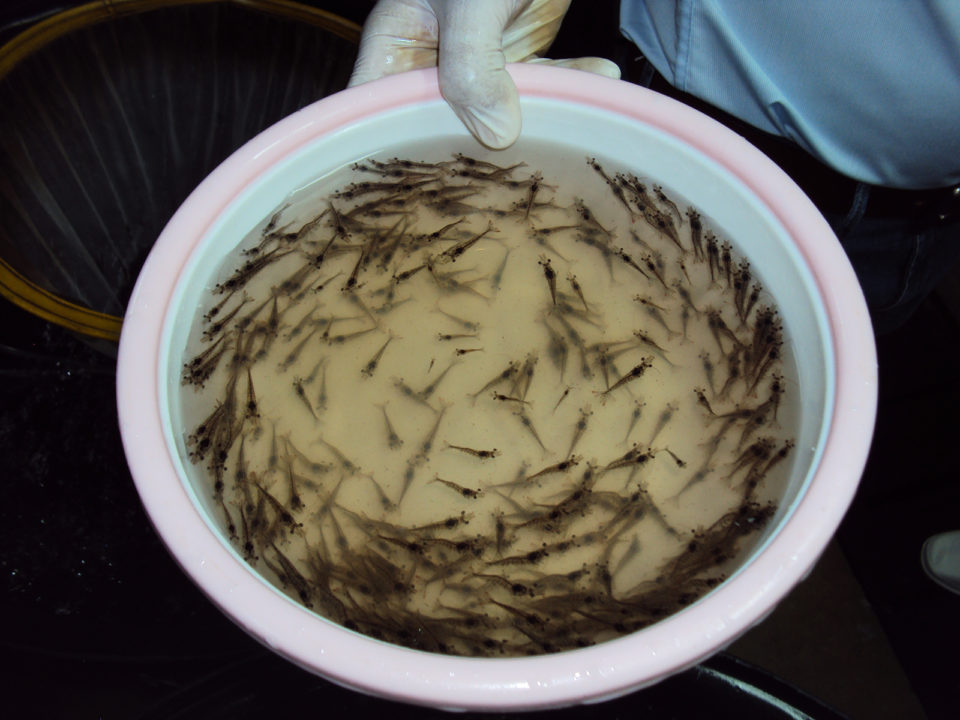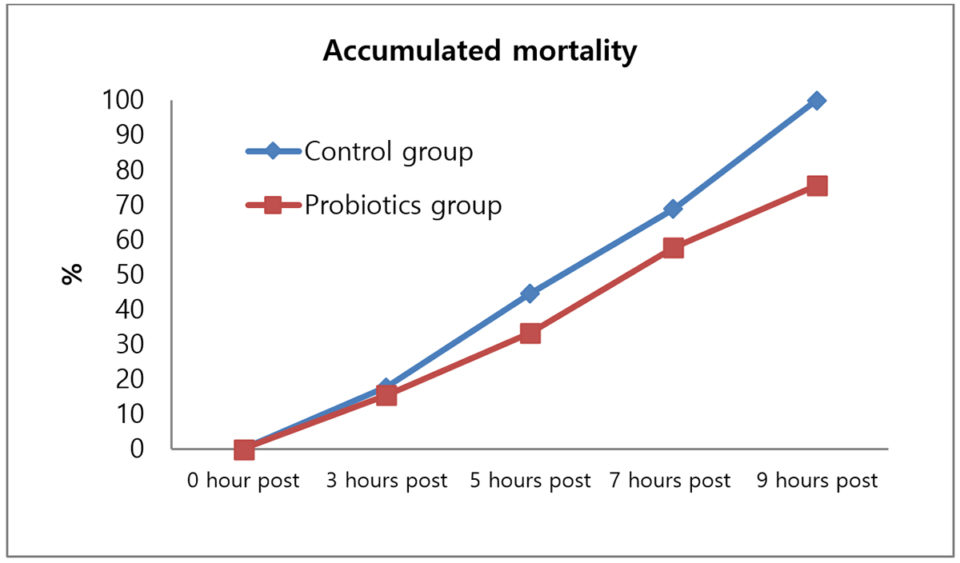Feeding study sees improvement in growth performance, feed utilization, survival

Bacillus probiotics are spore-forming bacteria that are heat stable and are able to survive passage through the acidic stomach and make it to the gut, where they confer unique health benefits. In this study, we investigated the effects of supplementing three Bacillus species (B. subtilis, B. pumilus, and B. licheniformis) on growth performance, feed efficiency and survival (ammonium stress) in Pacific whiteleg shrimp juveniles. We thank all the staff at Nong Lam University, Ho Chi Minh City, Vietnam, for their technical assistance.
Experimental design
Whiteleg shrimp (Litopenaeus vannamei) postlarvae were cultured and acclimated in confined water tanks for one month to reach an average weight of 2.3 grams. From these, selected shrimp juveniles (n = 600) were randomly distributed into 500-liter circular tanks at a stocking density of 100 shrimp per tank. The experimental system included six tanks connected through a recycled water system with mechanical aeration and a bio-filter, and salinity was kept at 10 ppt.
Experimental diets were prepared by supplementing three powder forms of Bacillus spp. (1 × 109 CFU/g) with a combination of B. subtilis, B. pumilus and B. licheniformis at 0.2 percent, and a 40 percent fishmeal-based diet was formulated as a basal diet. Two dietary treatments were tested, and a control (without probiotics vs. with probiotics). The bacteria were originally isolated from seawater or intestinal microflora of shrimp and cultured, and their purity was routinely monitored. The tested Bacillus spp. were provided in an endospore form from the Bio-Resources Research Institute, CJ CheilJedang Corp. (Suwon, South Korea).
In the shrimp bioassay, shrimp were fed to satiation four times per day with the feeding rate estimated from 3 to 10 percent body weight. Unfed feed was collected, preserved in freezer, and used to calculate the real consumed feed from the distributed sum. Each diet was fed in three tanks.
Growth performance and feed utilization
The feeding trial lasted for eight weeks and the experimental animals reach a harvest weight of 15 to 20 grams. All shrimp in each experimental unit was weighed (initial and final weights). To evaluate growth performances and feed utilization of the shrimp, daily weight gain (DWG), specific growth rate (SGR) and feed conversion ratio (FCR) were calculated. Mortality in each tank was recorded daily during the entire experimental period in order to calculate survival rate. The following formulas were used
DWG = [(Wt2 – Wt1)/(/T2 – T1)] x 100 (g/shrimp/day)
where:
Wt1 = average weight at the beginning of the experiment
Wt2 = average weight at the end of the experiment
SGR = [(LnW2 – LnW1)/(T2 – T1)] x 100 (%/day)
where:
W2 = average weight at the end of the experiment
W1 = average weight at the beginning of the experiment
T2 – T1 = duration of the experiment
FCR = total feed intake/shrimp growth (W2 – W1)
Feed intake = total feed intake/total shrimp (g/shrimp/day)
Han, Bacillus, Table 1
| Control group | Probiotics group | |
|---|---|---|
| Initial weight (g) | 2.37 | 2.32 |
| Final weight (g) | 16.8 | 17.7 |
| DWG (g/shrimp/day) | 0.26 | 0.27 |
| SGR (%/day) | 3.47 | 3.62 |
| Feed intake (g/shrimp/day) | 0.22 | 0.24 |
| FCR 1 | 2.30 | 2.06 |
| FCR 2 | 2.14 | 1.97 |
| Survival rate (%) | 74.0 | 78.7 |
DWG = daily weight gain
SGR = specific growth rates
FCR 1 = total feed intake per tank/total shrimp growth per tank (total W2 – total W1)
FCR 2 = feed per shrimp/(average final weight – average initial weight)
Ammonia challenge test
At the end of the feeding trial, 15 shrimp in each tank were maintained in the tank and then the ammonia concentration in the tanks was increased to 40 to 50 mg/L at pH 8.0 (lethal dose for 50 percent of animals, LD50) using ammonium chloride (NH4Cl), to evaluate stress resistance of shrimp. Mortality was observed until the shrimp all died, and results are shown in Fig. 1.

Conclusions
During the study, all experimental diets were readily accepted by the Pacific whiteleg shrimp at the start of the feeding trial, and they consumed those aggressively during the eight weeks of the feeding trial. Results showed that when the Bacillus species were supplemented in an appropriate concentration into feeds, the growth and feed efficiency of whiteleg shrimp could be improved; and that the survival rate of shrimp could be greatly improved under both normal and stressed (high ammonia levels) conditions. Further studies are needed to evaluate the effectiveness of the Bacillus probiotics on shrimp in field trials.
Authors
-

Jee Eun Han, DVM, Ph.D.
Biotechnology Research Institute
CJ CheilJedang, Suwon
Republic of Korea -
Ji Eun Kim, M.S.
Biotechnology Research Institute
CJ CheilJedang, Suwon
Republic of Korea
-
Sung Hun Kim, Ph.D.
Biotechnology Research Institute
CJ CheilJedang, Suwon
Republic of Korea -
Jong-Su Eun, Ph.D.
Biotechnology Research Institute
CJ CheilJedang, Suwon
Republic of Korea -
Se Min Choi, Ph.D.
Biotechnology Research Institute
CJ CheilJedang, Suwon
Republic of Korea
Tagged With
Related Posts

Health & Welfare
Bacillus probiotics improve hatchery, nursery production in EMS-hit Mexico
In early 2014, a trial to evaluate the effects of a mixture of Bacillus strains on early mortality syndrome bacteria during the larviculture and nursery phases for shrimp was carried out at a commercial hatchery in Mexico.

Health & Welfare
Bacillus probiotics benefit tilapia rearing under challenging conditions in Brazil
A recent study that evaluated the benefits of using probiotics with a balanced mixture of Bacillus bacteria strains to inhibit pathogenic bacteria in tilapia.

Health & Welfare
Prebiotics and their role in sustainable aquaculture
Results of a study to evaluate a commercial prebiotic on growth of European sea bass juveniles indicates this product can improve fish growth performance and allowing for the fish to reach the marketable size earlier, boosting their immune status, and reducing potential fish losses due to pathogens.

Health & Welfare
Biosecurity practices on fish farms need beefing up
Biosecurity measures and preventive strategies are essential in any biological production chain. Properly planned and implemented biosecurity programs will enhance animal health, production and economics.


